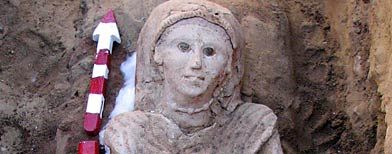Scientific Minds Want To Know

Greco-Roman mummy unearthed in Egypt
Fourteen ancient tombs are discovered at the site of a planned youth center.
Also: How interfering humans helped Amazon diversity

Even before Europeans arrived, farmers were changing South American ecosystems with a landscaping method previously unrecognized in the region
Stellar 'pollution' may be remains of watery planets

Atmospheric pollution on white dwarf stars could be a sign of destroyed watery exoplanets – suggesting that Earth-like worlds are common
Resurrecting ancient viruses

Roughly 8 percent of your DNA isn't really human. (How's that for a morning wake-up call?)
Instead, it's the de-activated remnants of ancient retroviruses. All viruses hijack host cell machinery to replicate themselves, but retroviruses are a little more invasive than most. These viruses trick cells into turning viral RNA into DNA—the reverse of the normal DNA to RNA transcription process—and then snuggle that DNA right into the rest of the host's genome. They mutate frequently and, sometimes, accidentally deactivate themselves—in which case the "dead" viral DNA just ends up hanging out in the human genome.It's a sneaky tactic that makes retroviruses—including HIV—difficult to fight. But it also leaves researchers "fossils" to study, physical evidence of viral evolution and adaptation that isn't really available any other way. Scientists can separate out the viral DNA from the human, and use it to learn how to better fight modern retroviruses.
Now, the jaw dropping part. That image above? That's a picture of particles of an ancient virus, budding off of a modern cell. Researchers at Rockefeller University in New York used computer models to estimate what mutated viral DNA taken from the human genome would have originally looked like, and replicated a working version.
Read more:
 From NASA Jet Propulsion Laboratory yesterday, this gorgeous new image from The Herschel Space Observatory: "a cosmic garden of budding stars, each expected to grow to 10 times the mass of our sun." The image was taken of the Rosette Nebula using infrared light by Herschel, a European Space Agency mission with important NASA participation. More here, including higher-resolution formats.
From NASA Jet Propulsion Laboratory yesterday, this gorgeous new image from The Herschel Space Observatory: "a cosmic garden of budding stars, each expected to grow to 10 times the mass of our sun." The image was taken of the Rosette Nebula using infrared light by Herschel, a European Space Agency mission with important NASA participation. More here, including higher-resolution formats.

No comments:
Post a Comment